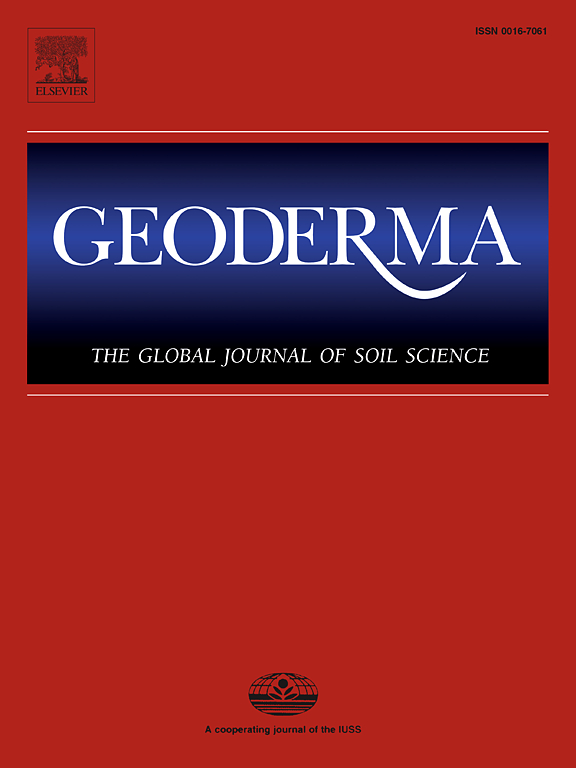Advancing digital soil mapping with multi-year crop cover data: Impacts on model accuracy and soil interpretation
IF 6.6
1区 农林科学
Q1 SOIL SCIENCE
引用次数: 0
Abstract
Vegetation cover has a significant influence on soil properties and is commonly used as a covariate in digital soil mapping (DSM). Crop frequency (CrFr) covariates, representing the frequency with which a certain crop or class of crops are grown over multiple years, can be derived from multi-year vegetation data. Such data have the potential to provide promising insights into soil conditions and can enhance predictions of soil properties. Predictive modelling within a DSM framework can improve our understanding of the relationship between crop cover and different soil properties. This study had two main objectives: (1) to develop DSM models for six soil properties—bulk density (BD), organic carbon (OC), A horizon thickness (AT), total nitrogen (TN), pH, and cation exchange capacity (CEC)—both with and without CrFr covariates, and to compare their accuracy metrics; each soil property was modelled independently as a separate response variable; and (2) to investigate the relationships between covariates such as crop types, precipitation, and temperature and soil properties. The study was conducted in the Ottawa, Canada, region, an area with diverse crop cover. From 13 years of Annual Crop Inventory (ACI) raster data, five CrFr covariates were generated and added to other covariates commonly used in DSM, resulting in a total of 54 covariates for model training. Twelve models were developed for the six soil properties, both with and without CrFr covariates. Validation results showed that including CrFr covariates improved the accuracy of models for BD, OC, AT, and TN. However, the impact on models for pH and CEC was minimal, indicating that intrinsic soil factors likely influence these properties more than CrFr. Partial dependence plots indicated that the models captured expected patterns, such as the negative association of forest cover with BD and its positive relationship with OC and TN. In contrast, crops such as legumes and corn exhibit the opposite effects. Forests exhibited a negative relationship with AT, whereas croplands showed a positive association, indicating a likely difference between the Ap horizon and Ah. Uncertainty analysis revealed lower uncertainty in agricultural cropland areas and those with lower elevations. This study highlights the potential of DSM in assessing the impact of crop type on soils and suggesting what crops may be more beneficial for soil.
利用多年作物覆盖数据推进数字土壤制图:对模型精度和土壤解释的影响
植被覆盖度对土壤性质有重要影响,是数字土壤制图(DSM)中常用的协变量。作物频率(CrFr)协变量,代表某一作物或某类作物在多年内生长的频率,可以从多年的植被数据中得出。这些数据有可能为土壤状况提供有希望的见解,并可以增强对土壤性质的预测。DSM框架内的预测建模可以提高我们对作物覆盖与不同土壤性质之间关系的理解。本研究有两个主要目标:(1)建立包含和不包含CrFr协变量的6种土壤特性——体积密度(BD)、有机碳(OC)、土层厚度(AT)、总氮(TN)、pH和阳离子交换容量(CEC)的DSM模型,并比较它们的精度指标;每个土壤属性作为一个单独的响应变量独立建模;(2)研究作物类型、降水、温度和土壤性质等协变量之间的关系。这项研究是在加拿大渥太华地区进行的,该地区有多种作物覆盖。从13年的年度作物清单(Annual Crop Inventory, ACI)栅格数据中,生成5个CrFr协变量,并将其添加到DSM中常用的其他协变量中,总共有54个协变量用于模型训练。针对6种土壤性质,建立了12个模型,包括有或没有CrFr协变量。验证结果表明,纳入CrFr协变量提高了BD、OC、AT和TN模型的准确性。然而,对pH和CEC模型的影响微乎其微,这表明土壤内在因子可能比CrFr更能影响这些特性。部分依赖图显示,模型捕获了预期的模式,如森林覆盖与BD呈负相关,与OC和TN呈正相关。相反,豆类和玉米等作物表现出相反的效应。森林与AT呈负相关,而农田与AT呈正相关,表明Ap水平与Ah水平可能存在差异。不确定度分析显示,农业耕地和低海拔地区的不确定度较低。这项研究强调了DSM在评估作物类型对土壤的影响方面的潜力,并建议哪些作物可能对土壤更有益。
本文章由计算机程序翻译,如有差异,请以英文原文为准。
求助全文
约1分钟内获得全文
求助全文
来源期刊

Geoderma
农林科学-土壤科学
CiteScore
11.80
自引率
6.60%
发文量
597
审稿时长
58 days
期刊介绍:
Geoderma - the global journal of soil science - welcomes authors, readers and soil research from all parts of the world, encourages worldwide soil studies, and embraces all aspects of soil science and its associated pedagogy. The journal particularly welcomes interdisciplinary work focusing on dynamic soil processes and functions across space and time.
 求助内容:
求助内容: 应助结果提醒方式:
应助结果提醒方式:


